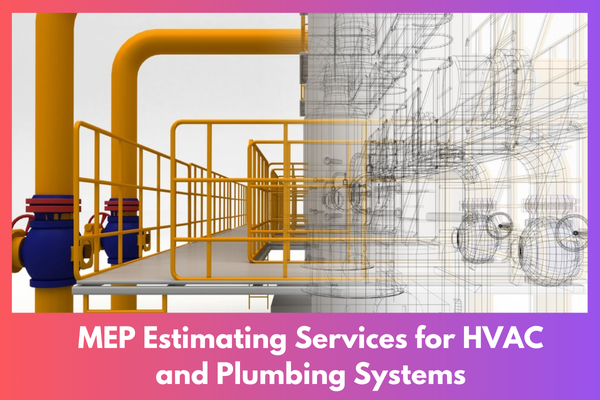Mechanical, electrical, and plumbing (MEP) systems are the backbone of any modern building project, ensuring functionality, safety, and comfort. Accurate estimation of HVAC (heating, ventilation, and air conditioning) and plumbing systems is crucial for project success. Contractors and engineers rely on professional MEP estimating services to provide detailed and reliable cost analyses, enabling efficient project planning and execution.
In this article, we will explore the significance of MEP estimating services for HVAC and plumbing systems, the components of accurate estimates, and how precision estimator play a vital role in delivering high-quality, comprehensive reports.
What Are MEP Estimating Services?
MEP estimating services encompass a detailed analysis of the costs associated with mechanical, electrical, and plumbing systems in a construction project. For HVAC and plumbing, this includes:
- Material Costs: Piping, ductwork, valves, fittings, and HVAC equipment such as chillers, boilers, and air handling units.
- Labor Costs: Skilled and unskilled labor required for installation, testing, and commissioning.
- Equipment and Tooling: Costs for specialized tools and equipment rentals.
- Overheads and Contingencies: Allowances for unforeseen expenses and project-specific requirements.
- Regulatory Compliance: Costs associated with meeting building codes, safety standards, and certifications.
Professional MEP estimating services ensure these factors are accurately accounted for, reducing the risk of budget overruns and project delays.
Importance of Accurate MEP Estimation for HVAC and Plumbing Systems
1. Efficient Resource Allocation
An accurate estimate ensures that resources such as materials, labor, and equipment are procured and allocated efficiently. This prevents waste and ensures timely project execution.
2. Cost Control
HVAC and plumbing systems often represent a significant portion of a project’s budget. Precise estimates enable contractors to control costs, avoid overruns, and stay within budget.
3. Project Feasibility
Detailed estimates provide stakeholders with a clear understanding of the financial and logistical requirements of the project, aiding in decision-making and ensuring project feasibility.
4. Competitive Bidding
For contractors, submitting a competitive bid with accurate cost projections increases the likelihood of winning projects without compromising profitability.
5. Risk Mitigation
By accounting for contingencies and potential challenges, accurate estimates help mitigate risks associated with unexpected expenses or delays.
Key Components of MEP Estimating for HVAC and Plumbing Systems
1. Material Takeoffs
Material takeoffs involve quantifying all materials required for the HVAC and plumbing systems, including:
- Ductwork and piping.
- HVAC units such as chillers, condensers, and air handlers.
- Valves, fittings, and fixtures for plumbing systems.
- Insulation, fasteners, and other ancillary items.
2. Labor Estimation
Labor costs depend on the complexity of the project and the expertise required. Estimators account for:
- Installation of HVAC ducting, equipment, and controls.
- Plumbing system installation, including piping, drainage, and fixtures.
- Testing, balancing, and commissioning of systems.
3. Equipment Costs
This includes costs for renting or purchasing specialized equipment such as:
- HVAC testing and balancing tools.
- Pipe threading and welding machines.
- Cranes or lifts for heavy installations.
4. Compliance Costs
Adhering to local codes and regulations is mandatory. Estimators factor in expenses related to:
- Obtaining permits and certifications.
- Ensuring systems meet environmental and safety standards.
5. Overhead and Contingencies
Overhead costs include administrative expenses, while contingencies cover unforeseen challenges such as material shortages or design changes.
The Role of a Precision Estimator in MEP Projects
A precision estimator specializes in creating detailed and accurate cost analyses for complex MEP systems. Their expertise ensures that HVAC and plumbing systems are accurately represented in project budgets.
Responsibilities of a Precision Estimator:
- Analyzing Design Documents
Reviewing blueprints, specifications, and technical drawings to understand project scope and requirements. - Conducting Site Assessments
Inspecting sites to evaluate conditions that may impact installation or costs, such as existing infrastructure or accessibility challenges. - Leveraging Advanced Tools
Using specialized software like PlanSwift, Trimble, or AutoCAD to generate precise material takeoffs and cost estimates. - Market Research
Staying informed about fluctuations in material prices, labor rates, and industry trends to provide accurate, up-to-date estimates. - Providing Comprehensive Reports
Creating detailed reports that break down costs by category, offering stakeholders clear insights into budget requirements. - Collaborating with Stakeholders
Working closely with engineers, project managers, and contractors to align estimates with project goals and address any discrepancies.
Challenges in MEP Estimation for HVAC and Plumbing Systems
1. Complexity of Systems
HVAC and plumbing systems involve numerous interconnected components. Estimators must have a thorough understanding of system design and functionality to create accurate estimates.
2. Market Volatility
Material and labor costs can fluctuate due to market conditions, impacting the accuracy of estimates.
3. Tight Deadlines
Projects often require quick turnaround times for estimates, increasing the pressure to deliver accurate results efficiently.
4. Evolving Project Requirements
Changes in project scope or design can affect estimates, requiring adaptability and regular updates.
Best Practices for Accurate MEP Estimating
1. Utilize Advanced Software
Software tools such as Bluebeam and Trimble Estimation streamline the estimating process, reducing errors and saving time.
2. Maintain a Comprehensive Database
A database of material costs, labor rates, and historical project data can serve as a valuable reference for creating accurate estimates.
3. Collaborate with Experts
Engage with engineers, architects, and project managers to ensure estimates align with project objectives and technical requirements.
4. Include Contingency Allowances
Incorporate a contingency budget to account for unforeseen challenges, typically 5-10% of the total cost.
5. Regularly Update Estimates
Revisit and revise estimates as project designs evolve or market conditions change, ensuring they remain accurate and relevant.
Benefits of Professional MEP Estimating Services
1. Time and Cost Savings
Outsourcing estimating services allows contractors to focus on core activities, saving time and ensuring cost efficiency.
2. Improved Decision-Making
Detailed and accurate estimates provide stakeholders with the insights needed to make informed decisions about project feasibility and resource allocation.
3. Enhanced Client Confidence
Professional estimates with comprehensive reports demonstrate expertise and reliability, strengthening client relationships.
4. Reduced Risk of Budget Overruns
Accurate estimates minimize the risk of unexpected expenses, keeping projects on budget.
5. Competitive Edge
Contractors with reliable estimating services can submit competitive bids, increasing their chances of winning projects.
Conclusion
MEP estimating services are a vital component of successful construction projects, particularly for HVAC and plumbing systems. Accurate estimates ensure efficient resource allocation, cost control, and risk mitigation, enabling projects to stay on track and within budget.
The expertise of precision estimator and the use of advanced tools play a pivotal role in delivering high-quality, detailed reports that provide stakeholders with the clarity and confidence needed for effective project planning. By investing in professional MEP estimating services, contractors can enhance their reputation, improve client satisfaction, and achieve long-term success in a competitive industry.



